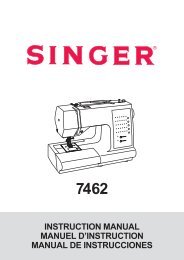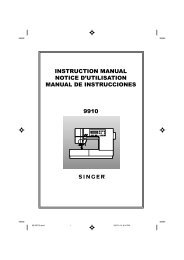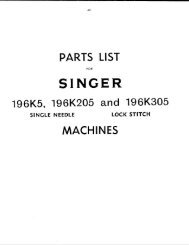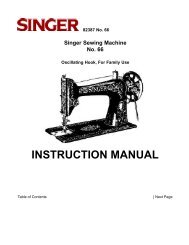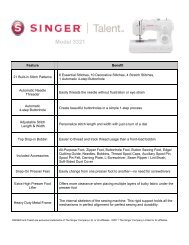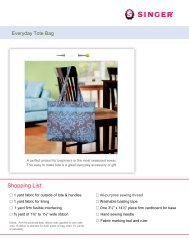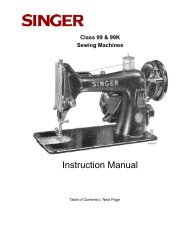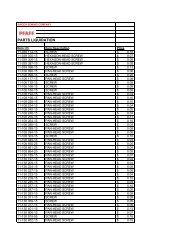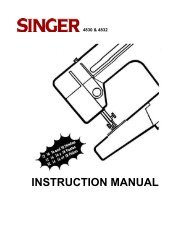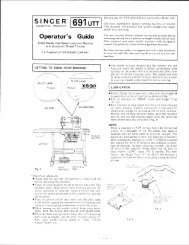Untitled - Singer
Untitled - Singer
Untitled - Singer
You also want an ePaper? Increase the reach of your titles
YUMPU automatically turns print PDFs into web optimized ePapers that Google loves.
Straight Stitching, Reverse and Needle PositionsMachine Set-Up:Stitch:“A”, Straight StitchStitch Width: 0, Center Needle PositionStitch Length: 3Presser Foot: Standard FootMaterials:(2) 5” X 5” pieces of medium weight cottonProcedures:Sew a straight stitch on the fabric.Change the stitch width to 3, notice the needle position changes.Sew another row of straight stitching.Change the stitch width to 7, notice the needle is in the far left position.Sew a straight stitch and compare the differences in needle position.Sew a straight seam and practice reinforcing the seam using thereverse knob.Change the stitch length dial to 1, begin to sew.Slowly move the stitch length dial to 7, notice how close or far apart thestitches look depending on the stitch length setting.1
Straight StitchingMachine Set-up:Stitch:“A”, Straight StitchStitch Width: 0, Center Needle PositionStitch Length: 3Presser Foot: Standard FootMaterials:(2) 5” X 5” pieces of cotton with a piece of batting between the two pieces,creating a quilt-type sampleProcedure:Sew diagonally from the top left corner to the bottom right corner.Use the reverse lever to reinforce the seam.2
Create Quilted FabricMachine Set-Up:Stitch:“A”, Straight StitchStitch Width: 0, Center Needle PositionStitch Length: 2.5Presser Foot: Standard FootMaterials:Quilt-type sample that was previously used on the Straight Stitch exerciseProcedure:Attach the Seam/Quilt guide.Quilt pillow tops for a designer look!Use the guide to ensure even spacing and straight lines,or when large (projects cover the machine’s seam guideson throat plate)Position fabric approximately 1-2 inches from theright of the previously sewn straight stitch.Position the guide so that it rides on the previous row of stitching.Sew successive rows using the guide.Change the direction, sew diagonally from the top right corner to thebottom left corner of the fabric.Sew 3 or more rows, using the guide.3
Create PipingMachine Set-up:Stitch:“A”, Straight StitchStitch Width: 3Stitch Length: 3Presser Foot: Zipper FootMaterials:5” X 6” home décor fabric, cut on bias7” of purchased cordingProcedure:Fold fabric wrong sides together.Place cording inside of the fold.Attach piping to pillowsand furniture to add a boldfinishing touch!On the right side of the fabric sew a straight stitch close to the piping. Adjust stitch width to move the needle closer to the pipingNoteNote: The Zipper Foot can be attached right or left, allowing forthe cording to be inserted from either side.4
Satin Stitch AppliquéMachine Set-up:Stitch:“B”, Zigzag StitchStitch Width: 3Stitch Length: -1Presser Foot: Satin FootMaterials:A simple-shaped appliqué fused onto a cotton-typefabric (base fabric), with a medium weighttear-away stabilizer underneath. Fusing theappliqué into place will prevent the appliqué from shifting while stitching. Thestabilizer underneath the fabric is used to support the fabric when using widedense stitches.Procedure:A close zigzag is called a Satin Stitch.Place the applique under the transparent foot, so that the left swing of theneedle falls on the applique and the right swing of the needle falls on thebase fabric.Stitch around the applique.Widen the stitch width to 4 and change the stitch length to below 1.Stitch around the applique again, covering the previously sewn stitching.Sewing over an applique twice is not always necessary, however, it doesgive a beautiful full-covered or raised effect.5
Machine Set-Up:Stitch:Stitch Width:Stitch Length:Feed Dogs:Presser Foot:Button Sewing“B”, ZigzagDetermined by button (usually 3mm)(does not apply because feed dogs are lowered)Down PositionButton Sewing FootMaterials:Home Décor fabric or shirting(1) two-hole buttonProcedure:Fold fabric in half and place under foot.Position the button on the fabric so that the holes in the button arebetween the toes of the foot.Lower the presser foot to hold the button in place.Turn the hand wheel forward, adjust so that the needle goes into eitherthe right or left hole.Adjust the stitch width dial to fine tune the swing of the needle into theother hole.Recheck the swing of the needle into the other hole. Now use the footcontrol to stitch 6-8 stitches.Use buttonholes and decorativebuttons for versatile and stylishtabs on curtains.6
Before removing the button and fabric from the machine, set machineto straight stitch. Leave width at current setting and stitch in place forthree stitches. This forms a tie-off on the back side to secure the button.Apply a liquid fray-preventer on the backside of fabric on the knots.Trim threads after they dry, being careful not to cut thread knots.Note:Note: Remember to raise the feed dogs when finished.For a thread shank, place a needle or toothpick on the button and stitch.Use decorative buttons to tie-off a quilt or wall hanging!7
Bartack ButtonholesMachine Set-Up:Stitch:Step One of the Four-Step ButtonholeStitch Width: 5-7Stitch Length: Buttonhole symbolPresser Foot: Buttonhole Foot (after attaching, push the moveablewhite part to most rear position)Materials:Home décor fabric with interfacing or tear-away stabilizerDisappearing marking pen or tailor chalk (for marking size of buttonhole)Button (to establish length of buttonhole)Procedure:Fold fabric in half crosswise, with interfacing or stabilizer between layers.Lay button on fabric and mark the top and bottom of the button.This will establish the starting and ending points of the buttonhole.Push the foot’s white movable piece to the most forward red line onthe foot.Place the fabric under the foot, matching the foot’s red mark with thebottom mark on the fabric.Sew 5 to 6 stitches of Step One (which is the lower/bottom bartack)Cut open buttonhole and use a seam sealant to reinforce the buttonhole.Note: To adjust the density or if the sides are uneven, refer to the manualfor adjustment instructions.8
Turn Pattern Selection knob to Step Two of the Four-Step buttonhole.Sew, and the machine will stitch in reverse, making left side of thebuttonhole.Stop sewing when the needle reaches the fabric mark indicating the topof the buttonhole.Turn Pattern Selection knob to Step Three, the upper/top bartack.Sew 5 to 6 stitches.Turn Pattern Selection knob to Step Four, to form the right side of thebuttonhole.Sew, the machine will stitch forward, making the final side of thebuttonhole.Stop sewing when the needle reaches the bottom of the buttonhole,indicated by the mark on the fabric.Cut open buttonhole and use a seam sealant to reinforce the buttonhole.9
Blind HemMachine Set-Up:Set-up for Step 1 (to finish raw edges)Stitch:“E”, Multi-ZigzagStitch Length: 1.0Stitch Width: 5Presser Foot: Standard FootSet-up for Step 2 (to baste the fold)Stitch:”A”, Straight StitchStitch Length: 4Stitch Width: 0Tension Dial: 1Presser Foot: Standard FootUse the Blind hem to finish theedges of tablecloths and drapes.Set-up for Step 3 (to create the hem)Stitch:“D”, BlindhemStitch Length: 2.5-3.5Stitch Width 3-4Tension Dial: 2Presser Foot: “F”, Blindhem FootMaterials:Medium weight woven fabricProcedure:Sew a Multi-Zigzag to finish one of the fabric’ s raw edges.Guide the fabric so the right swing of the needle is on theraw edge of the fabric.10
Fold under 1 “ and baste in place.Position sample with wrong side facing up, and turn the hem back to theright side, creating a soft fold at the top edge of the hem. The bulk of thefabric is to the left of the foot.Begin stitching, making sure the forward stitches fall near the finishededge, and the needle’s left swing just bites into the fold, catching only2 or 3 threads of the fabric.Note: Always use matching thread to help “hide” the stitches.11
Narrow Hem(optional foot for Quantum 7312)Machine Set-Up:Stitch:“A”, Straight StitchStitch Width: 0, Center Needle PositionStitch Length: 2Presser Foot: Rolled or Narrow Hem FootMaterials:Medium to light weight cotton fabricUse the Narrow Hem to createdelicate edge finishes.Procedure:To start the hem at the very edge of the fabric:Fold over a 1/8” of the fabric’s edge at the starting point for a distance of aabout an inch.Fold the fabric over another 1/8”.Stitch the small hem into place with a Straight Stitch.Leave the needle in the fabric, but lift the presser foot.Guide the fabric into the scroll of the foot.Lower foot and continue to sew, holding the thread tails firmly behind thefoot.Hold fabric taut and slightly up to help the fabric “roll” into the scroll.The foot’s scroll12
Gathering with the Cording FootMachine Set-Up:Stitch:“B”, ZigzagStitch Width: 3Stitch Length: 3Presser Foot: Cording FootMaterials:10” long cord of pearl cotton or string5” X 3” Home Décor fabricProcedure:Place a single cord in the center groove of the foot.Secure the cord by tying a knot at the back of the foot.Place the fabric under the foot.Sew a test to ensure that the Zigzag stitches are sewing over the cord, notinto the cord. The Zigzag stitch makes a casing for the cord.After stitching is finished, pull the cord which will draw up or gather thefabric.Adjust the gathers evenly by sliding the fabric along the cord. Sew a straight stitch to secure the gathers into place.Note:This technique is great for heavy fabrics such as home decorator ortextured fabrics.13
Applying Trims, Cords or BraidsMachine Set-Up:Stitch:“I”, Decorative StitchStitch Width: 5-7Stitch Length: 1Presser Foot: Cording FootMaterials:Three strands of thin cordingHome Décor fabricProcedure:Thread one decorative cord through each of the foot’s three grooves orslots.Secure the three cords at the back of the foot by tying a knot.Place the fabric under the foot and sew.The foot will hold all the cords in place as they are sewn to the fabric.Note:There are several decorative cords available, eachcreating unique effects to projects.♍ Experiment with different cords and variousZigzag-type stitches!14
Attaching Beaded TrimsMachine Set-Up:Stitch:“E”, Multi-MendingStitch Width: 5-7Stitch Length: 2Presser Foot: Standard FootMaterials:Beaded trimHome Décor fabricAttach trim to add aspecial finishing touch!Procedure:Press and stitch with a straight stitch a 1” hem into the fabric. Finishedges if needed.Place fabric on machine with wrong side facing up.Place trim header on fabric’s edge, right side facing down.Sew on the the trim’s header.Stitch the trim to the fabric at the trim’s header.Fabric’s wrong side15
Couching a Strand of PearlsMachine Set-Up:Stitch:“B”, ZigzagStitch Width: Adjust according to size of pearlsStitch Length: 2-3Presser Foot: Standard FootTension: 2-3Materials:Monofilament ThreadString of Pearls, size 3mmFelt or Stabilized Woven FabricProcedure:Lay pearls or other couching trim on top of fabric.Stitch, adjusting width to ensure the stitch slightly encases the trim.16
Faux Tatted or Crocheted EdgingMachine Set-up:Stitch:“K”, Decorative StitchStitch Width: 7Stitch Length: 4Presser Foot: Standard FootNote:Use a size 90/14 or larger needleMaterials:Linen-like fabric, starched and one long edge hemmed25wt. cotton thread in both needle and bobbinRinse-away stabilizer—folded to create double layerProcedure:Position stabilizer under the hemmed edge of the fabric, with the bulkof the fabric to the left of the presser foot.Stitch so that the left swing of the needle just penetrates the foldededge of the fabric, and the rest of the stitch penetrates the stabilizer.Secure thread tails on both ends by tying square knots before trimmingthem.A drop of liquid fray preventer will ensure that stitching will notcome undone.17
Crazy QuiltingMachine Set-Up:Stitch:H, I, K, LRed stretch stitches: A, B, E, F, G, H, I, K, L*Stitch Width: Adjust according to preferenceStitch Length: Adjust according to preferencePresser Foot: Satin Foot or Standard Foot*The Red Stretch stitches are only found on the Quantum Decor.Materials:Assorted fabric scrapsFoundation fabric or paperProcedure:Create Crazy Quilt bed coverswith left over scraps!Crazy-piece the scraps onto the foundation fabric or paper, starting fromthe center and working outward.Select desired decorative stitch and center the stitching over the seam lines.Use rayon, metallic or other decorative threads.Note:See the <strong>Singer</strong> Quilting Bible for more ideas on crazy quilting.18
Shirring with the Gathering FootMachine Set-Up:Stitch:“A”, Straight StitchStitch Width: 0, Centered Needle PositionStitch Length: 4Tension: Increase the tension to 9Presser Foot: Gathering FootMaterials:12” piece of organza (light weight fabrics recommended)Procedure:Shirr a single row to gather for a ruffle orshirr several rows for a textured effect.Pull one to two threads on the fabric’s crosswise grain, to create a straightstitching line.Turn the handwheel to ensure the needle is correctly positioned. Itshould line up with the Gathering Foot’s needle opening.Sew on the “pulled” line.Use the foot's edge as a guide to sew the next row of stitching. Rows willbe 1/4” apart if the foot is used as a guide.Sew 3 or 4 more rows.Note:After several rows of shirring have been sewn, use the Honeycomb stitch,Red Stretch “E” to tack the gathers into place, thus creating abeautiful smocking effect.19
Using the Even Feed Footto Sew Multiple Fabric Layers(optional for Quantum 7312)Machine Set-Up:Stitch:“A”, Straight StitchStitch Width: 0, Center Needle PositionStitch Length: 3Presser Foot: Even Feed FootMaterials:(2) 5” X 5” pieces of cotton with a piece of batting between the two fabricsProcedure:Sew from one edge to the other down the center of the fabric.The Even Feed Foot (also known as a Walking Foot) has itsown set of feed dogs that work in conjunction with the machine’sfeeding system to improve the flow of the fabric. This isparticularly important when sewing several layers of fabric, suchas in quilting. The Even Feed Foot “pulls” the top layer or layersof fabric through at the same speed as the machine’s feeddogs are pulling the bottom layer or layers of fabric- - -making for more even feeding!20
Using the Even Feed Footto Sew Plaid Fabrics(optional for Quantum 7312)Machine Set-Up:Stitch:“A”, Straight StitchStitch Width: 0, Center Needle PositionStitch Length: 3Presser Foot: Even Feed FootMaterials:(2) 5” X 5” pieces of plaid or striped fabricProcedure:Match plaids, right sides togetherSew the two pieces together using the built-in seam guide on the machineto maintain a consistent seam allowance.Match plaids, stripes or border prints with ease!21
Using the Even Feed Footto Sew Pile Fabrics(optional for Quantum 7312)Machine Set-Up:Stitch:“B”, ZigzagStitch Width: 2Stitch Length: 1.5Presser Foot: Even Feed FootMaterials:(2) 5” X 5” pieces of fake-furProcedure:Sew the two pieces together using the built-in seam guide on the machineto maintain a consistent seam allowance.The Even Feed Foot isgreat when making fakefurpillows, blankets andeven costumes or stuffedanimals!22
Straight Stretch Stitchfor Woven Fabrics(Quantum Décor model only)Machine Set-Up:Stitch:Stitch Width:Stitch Length:Presser Foot:Red Stretch “A”, Triple Straight Stitch0, Center Needle PositionRed “S” settingStandard FootMaterials:Denim, folded in halfProcedure:Stitch the two layers.This stitch is wonderful for built-in strength!It is ideal when sewing heavy-weight fabrics or tocreate a bolder straight stitch. Try it as a topstitchon jeans, or a home decorating project.The triple straight stitch provides excellentreinforcement for projects, such as stuffedanimals or upholstery.23
Straight Stretch Stitchfor Stretch Fabrics(Quantum Décor model only)Machine Set-Up:Stitch:Stitch Width:Stitch Length:Presser Foot:Red Stretch “A”, Triple Straight Stitch0, no widthRed “S” settingStandard FootMaterials:Knit fabric, folded in halfYellow Band NeedleProcedure:Stitch the two layers.After sewing, notice how the stitch stretches when the fabric is stretched.Try the Straight Stretch Stitch for “no-pop” seamson dance wear, workout clothes and bathing suits.24
Ribbing Application(Quantum Décor model only)Machine Set-Up:Stitch:Red Stretch “G”, Overedge stitchStitch Width: 7Stitch Length: Red “S”Presser Foot: Standard FootMaterials:6” X 6” Medium to heavy weight knit fabric or polar fleece3” X 6” RibbingProcedure:Cut a curve in the knit fabric to resemble a neckline.Fold ribbing in half lengthwise.Starting at the left side of the knit curve, place ribbing on front side ofcurve.Match all 3 cut edes and place under the foot.Line up fabric edges with guide on foot and stitch the length of the seam.Stretch ribbing slightly to fit the cut edge of the knit.When finished, lift foot and pull threads and fabric straight back behindfoot and trim.Note:The Overedge Stretch Stitch makes sewing seams in knits look asthough they were finished on a serger. This stitch is stronger and more durablethan overlock/serger stitching.25
Overedge Stitching(Quantum Décor model only)Machine Set-up:Stitch:“G”, Double OveredgeStitch Width: 5-7Stitch Length: 1.0Presser Foot: Standard FootMaterials:(2) pieces of woven fabricProcedure:Right sides together, place the fabric under the foot.Align the fabric’s edges with the foot’s edge.Use the Overedge stitch to finish almostevery seam...clean professional finishinside every sewing project !!!Sew, joining two pieces of fabric and finishing the edges in one operation.XXXXXXXXXXXXXXXXXXXXXXXXXXXX26
Attaching ElasticMachine Set-Up:Stitch:“E”, Multi-Zigzag or Red Stretch “E”, Honeycomb Stitch*Stitch Width: 7Stitch Length: 3 for Multi-Zigzag or Red “S” for Honeycomb Stitch*Presser Foot: Standard FootMaterials:Nylon Tricot 4” X 8”3/8” wide elastic strip, 7” longProcedure:Thread elastic through the needle-opening hole in the foot.Pull 2-3” of elastic to the back of the foot, enough to firmly grasp.Position fabric under the foot.Sew, gently stretching the elastic while sewing.NoteNote: The foot holds the elastic into place, making it easier to evenlystretch the elastic.Apply elastic on fittedsheets or babybumper covers!*Found only on the Quantum Décor.27
Sewing with a Wing NeedleMachine Set-Up:Stitch:“B”, Zigzag StitchStitch Width: 1Stitch Length: 5Presser Foot: Transparent Satin Foot or Standard FootNeedle:Wing NeedleNote:-For best results use a stitch with forward-back movement,so that the needle penetrates the same hole more thanonce.*-For more pronounced holes stitch over previous stitching,making sure the needle goes into the same holesMaterials:Linen or other natural fiber fabric– spray starch for added firmness60-80 weight white sewing thread60-80 weight white sewing thread in bobbinProcedure:Trace a design onto fabric using chalk, water-soluble or air-soluble marker.(use stencils, templates or create a design)Stitch along the drawn lines of the design.Use a Wing needle to create a beautiful hem-stitchingeffect on pillowcases, napkins, or table runners.*Found only on the Quantum Décor.28
Sewing on LeatherMachine Set-Up:Stitch:“A”, Straight StitchStitch Width: 0, Center Needle PositionStitch Length: 3-4Presser Foot: Transparent Satin Foot or Standard FootNeedle:Leather Needle (Wedge Needle)Materials:Fashion LeatherProcedure:Finger press a 1-inch hem in the leather.Sew, using the seam guides to ensure a straight stitching.Note:A Roller Foot or Even Feed Foot feeds the leather, vinyl or suedethrough the machine more easily.29
Decorative Bobbin WorkMachine Set-Up:Stitch:“G”, “I” or “J”, Decorative StitchStitch Width: 7Stitch Length: 3Presser Foot: Standard FootTension: 7-8Note: Any open stitch that does not have too muchforward/reverse or side-to-side movement works well.Materials:Felt or Stabilized Fabric2mm Silk Ribbon or light-weight yarnProcedure:Hand-wind ribbon onto bobbin, insert bobbin into the machine.by pass the tension in the bobbin.Place matching colored standard thread in the needle.Slowly stitch, with wrong side of the fabric facing up.Use this technique to create textured effects on crazy quilts, pillows trims,and more.30



